Use 'Print preview' to check the number of pages and printer settings.
Print functionality varies between browsers.
Printable page generated Thursday, 20 November 2025, 3:23 AM
Health Education, Advocacy and Community Mobilisation Module: 14. Implementing Health Education Programmes: 1
Study Session 14 Implementing Health Education Programmes: 1
Introduction
In Study Session 13, you learnt how to plan your health education activities, including selecting appropriate health education methods and developing your own work plans. In this study session, you will learn how to carry out your health education activities. This session builds on the work plan you developed in Study Session 13. A significant portion of your work as a Health Extension Practitioner will involve carrying out health education and health promotion activities. You have probably heard the old saying, ‘a plan that is not implemented is no plan at all’. Therefore in this study session, you will learn how to develop and implement a range of health education activities that will help you work with the people you are responsible for. More specifically, you will learn about the implementation process using community organising, training manpower, as well as identifying and utilising community resources.
Learning Outcomes for Study Session 14
When you have studied this session, you should be able to:
14.1 Define and use correctly all of the key words printed in bold. (SAQ 14.1)
14.2 Discuss how to implement your health education activities by organising the community. (SAQs 14.2 and 14.3)
14.3 Explain the reasons for training manpower to help you in your health education activities. (SAQ 14.4)
14.4 Describe various resources available within your own community and how to mobilise them. (SAQ 14.5)
14.1 Implementation
The word ‘implementation’ means to carry out. It is the act of converting your planning, goals, objectives and strategies into action. In other words, it is converting your planned activities into action — according to a plan of work. Conducting health education activities at a community gathering, or during home visits, are examples of implementation, or carrying out health education activities.
Community members should be involved in all your health education activities whenever possible. This should improve the uptake of your health education interventions, and enable you to pool community resources, including labour power. If the community seems reluctant to participate in health education activities, your plans stand much less chance of being successfully implemented. In order to avoid this difficulty, you should try to make sure that as many members of the community as possible are ready to participate in health education activities. To ensure participation, you should organise the community, and discuss with them the issues that you feel are important for the implementation of health education activities in their locality.
Box 14.1 Community organising
Community organising is the process of sensitising and empowering the community in such a way that they can identify and prioritise their needs and objectives. This will help them develop confidence and find resources through collaborative practices and community participation. Organising means bringing the community together for collective action.
Now look carefully at Box 14.1 above which describes what is meant by community organising. Think of a number of ways that you could organise health education activities in your own community.
To bring together the community, you will appreciate that being in touch with a wide range of groups with different interests will have the best chance of succeeding. Another well-known phrase is, ‘it takes all sorts of people to make the world’, and the many different people in your community may like many different activities, or come to health education from very different backgrounds. Organisation involves getting people involved in some way that feels right for them — in order that they can move forward to collective action.
When health workers or others organise their community, they build relationships among all those people who have common values, and who can participate in sustained social action (Figure 14.1). Therefore, community organising can be seen as the process of empowering individuals for collective action. When people become organised, they almost always feel commitment, and move forward together to achieve common goals. This is especially important in your work in improving the health of your community.
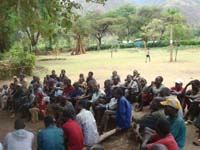
14.1.1 Methods of organising the community
There are different methods that you might be able to use in order to organise the community in which you work. You may be able to organise the community according to:
- Their place of work
- Common characteristics of the people
- The issue addressed
- Location or geography.
Look carefully at the list above. It shows some of the methods that you may be able to use to organise groups in your community. Think of examples from your own work for each item, where the community has been organised in this way.
Here are some examples. You may have thought of others as well. You can organise the community according to the following:
- Work place – for example; farmers’ association, teachers, or a student group.
- Common individual characteristics — for example, gender, or parents with young children.
- Issue you are dealing with — for instance, anti-AIDS club, women’s association, women’s idirs.
- Geography or location — you can organise people according to a specific part of a village.
According to your own interests and skills — and the needs within your community — you can organise the community to involve them in many different types of health education activities (Figure 14.2). It is best to begin with those people or groups who are already interested in addressing the community problem. In some situations, the community members may already be organised for certain purposes. In this case, you can assess the background and interest of the organised groups and work with them. So, you may not need to organise new groups if there are community groups which are already organised. Each community is different, and a variety of problems may occur. It is never easy to organise the community, and it may be possible for you to work with community leaders. Community leaders are often good organisers, and people tend to follow their example.
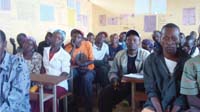
Look below at the characteristics of community leaders. Then think of examples from your own work where community leaders have played an important role.
- Community leaders can facilitate, and make easier, the organising process, — you may be able to identify community leaders and work with them.
- If possible, the leader should be someone with good leadership skills, as well as knowledge of the health problem, and of the community.
What sorts of features came into your mind as you thought about community leaders? Community leaders are usually able to ‘speak up’ for other people. They usually know a great deal of what is going on in their community. They also command the respect of the community. In this answer, we have highlighted some of the things which make community leaders such valuable allies.
14.1.2 How to identify community leaders
In order to identify community leaders who can help you to organise the community, first get the name of formal leaders like kebele leaders. Approach them, and ask them to recommend people in the community who are also considered to be good leaders. Then approach these other leaders, and ensure their willingness to work with you.
Pause for a moment, and think of the most appropriate community organisations that could become involved in health-related work in your community. Are there any such organisations in the community? Are they organised according to their work place, or are they issue based? Do members share common characteristics of geography or location? Do these organisations carry out health-related activities? Are they relevant for health education?
In any community, various community organisations are available, though they may vary from place to place, based on the purpose, norms and culture of the particular community. For instance, idir, iquib and mehber are among the common community organisations in Ethiopia. To work with these community groups, you should first approach the leaders of these groups and request their cooperation.
14.2 Training
Training is a special form of teaching that requires plenty of advance planning. Training refers to the teaching of vocational or practical skills and knowledge that relates to specific useful competencies. Teaching is basically imparting knowledge through learning, while training involves enhancing the skill through practice. It is through training that we can equip the individual and the community with the appropriate skills to deal with a wide variety of health issues. Once you have made contact with relevant community groups, you should help them acquire appropriate training so that they can participate in health education activities (Figure 14.3). Training is particularly important if these groups are newly organised.
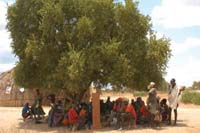
Why do you think that it is important to provide training for community members who will participate in health education activities? Do you think they can carry out this responsibility without being provided with appropriate training about ways in which it might be possible to educate their peers?
-
Community members may lack appropriate knowledge and skills to carry out necessary activities in the health field. Even if they have some information about health issues, they almost certainly will not have all the necessary information and skills to deliver the correct messages. Training will improve their knowledge and skills so they can participate in health education activities.
In the community, you may be able to identify many interested individuals, such as community leaders or religious leaders, kebele administrators, and other committed volunteers and individuals. You should plan how to equip them with appropriate knowledge and skills through training. This can also be a way of getting them to think about other possible health problems in the future. There are several steps that you will have to follow to provide training for existing, or newly organised community groups. These steps are set out in Box 14.2.
Box 14.2 Steps to use when conducting training for organised groups
- Select training participants
- Identify their need for training; identify the knowledge or skill gaps which would benefit from training
- Specify the objectives you intend to achieve through training
- Collect the necessary materials required to conduct the training sessions, including teaching materials and other resources
- Conduct the training session
- Obtain feedback from the participants, so that you can improve your future performance.
14.2.1 Conducting training sessions
During a training session, you should undertake the following activities:
- Start with introductions and/or an icebreaker activity. Welcome participants and introduce yourself by name to them. Talk briefly about why the training is important, and what your interest is in the training. Allow all the participants to introduce themselves. Adult learners appreciate an open, comfortable learning environment. Motivate participants at the beginning of a training session by introducing a fun activity (known as an ‘icebreaker’) that requires them to interact and learn more about each other (Figure 14.4). Do not spend too much time on these ‘icebreaker’ activities (recommended time is about 10 minutes).
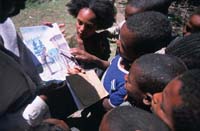 Figure 14.4 Community groups of all ages will require special health training in order to be able to tackle health issues (Photo: WaterAid/Caroline Irby)
Figure 14.4 Community groups of all ages will require special health training in order to be able to tackle health issues (Photo: WaterAid/Caroline Irby) - Describe the agenda. Explain to participants what training areas will be covered by the training, the order you will present topics, and how much time you will be spending on each one. Ask if they will need to modify or create their own agendas, according to their needs, culture, or customs.
- Gauge participants’ knowledge and interest. Before you start training, it is advisable to assess the participants’ level of knowledge and interests. To do so, you should ask participants to complete some questions prepared for this purpose — or you can do this orally by asking the participants. Allow about 10–15 minutes to complete this task. This enables you to adapt the training activities to the knowledge, skills, interests and culture of the training participants. As you start presenting each topic in turn, take a few minutes to find out how much participants know about the topic, and what areas they would like to focus on.
- Pay attention to participants. Do the participants look as though they are following the session well? Are they nodding, volunteering comments, and asking questions? Stop from time to time to ask for questions and ask how everyone is doing. If participants are tired or unengaged, you may need to slow down, turn the material into questions and generate discussion. Or it may be necessary to move more quickly, switch to a different type of activity, or take a short break. You can also revitalise their energy with a brief fun activity (either physical or not) that gets learning moving again.
- Be flexible. Some things may not go as you planned. Be aware that some of your activities may take longer or shorter than planned. Explain to participants what is going on if you need to deviate from the schedule you have laid out. If participants do not seem to be engaged in a given activity, be prepared to adjust, stretch, shrink or eliminate activities as necessary.
- Think about keeping the interest of participants. Keep the interest of participants. Start with simple concepts; build them into more complex ideas. Integrate physical movement, humour and practical demonstrations (Figure 14.5). Tailor the presentation or talk to the specific group of participants. Include and encourage personal stories and humour whenever possible.
- Conclusion. End each session with a summary, and a chance for participants to share their last thoughts. Ask everyone to share one thing that really stood out from the session.
- Evaluate each session. This enables you to find out what worked in your session. Ask participants to give you feedback, so you can find out what they learnt in your session, what they enjoyed most, and what they would change.
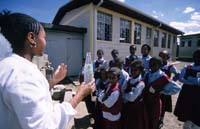
Have you ever received training? Do you have any comments on the way it was conducted? As you read the previous section about elements of a training session, think back to whether and when, as a trainee you have experienced these various elements. Was your experience good, bad or indifferent?
Most people can remember some training that they have received in the past. You can probably remember both good and bad points from the training that will help you plan your training sessions in the community. Some people have been to sessions where the icebreakers were boring or made people anxious. On other occasions, icebreakers have been a good way of getting to know the participants and helping everyone to feel relaxed. Remember that if you have had an unsatisfactory experience of a particular training activity, it just means that the person leading the activity did not have enough experience or understanding of how people learn. The training as a whole may have been good overall. Following steps 1–8 above should help you to make your training sessions work well for the participants.
14.3 Identifying and mobilising resources for health education
For health education activities to reach the stated goals and objectives, they must be supported with appropriate resources. In this section, you will have the opportunity to learn more about some sources of health education-related resources, and how to mobilise them.
There are several different types of resources that may be used in health education activities. They can be broadly classified into three items:
- Personnel or labour power
- Material resources, including educational materials
- Financial resources.
We will look at each of these in turn.
14.3.1 Personnel or labour power
The key to any successful health education activities will always be the individuals needed to carry them out (Figure 14.6). You are the primary person to put health education activities into practice within your own community. However, it is difficult for you to carry out every task. So you should be able to identify volunteer individuals from the community, such as community leaders, kebele leaders and possibly religious leaders. In addition, leaders of different community organisations such as idir, iquib and mehber may be very helpful. They may be able to assist you in organising the community, arranging schedules for health education, mobilising the community for participation, and even possibly delivering health education sessions for their followers themselves.
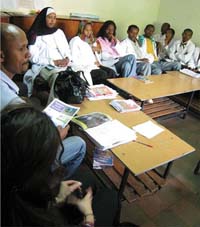
Other non-governmental organisations may be available in your community, and may be important sources of personnel for your activities. They may be able to assist you in different ways. For example, they may help you to provide training for peer educators or for households. In addition, you could request the woreda Health Office to provide you with assistance on certain issues. For example, the woreda Health Office might be able to provide you with teaching materials.
Look back at Section 14.1 which was about organising people, and remind yourself about whether in this section you thought about leaders of idir, iquib and mehber and whether you thought about approaching the kebele administrator.
However you go about training people, it is obviously very important to get a sense of who community leaders think will be good peers to be involved in health education. Using this knowledge is key to being able to target useful and enthusiastic people. So make sure you use your networks of key people.
14.3.2 Educational materials
Educational materials are crucial resources that will help you to carry out your health education activities. Some materials can help you take your message to the community, and also support your communication with all the people for whom you are responsible. You may be able to use posters, leaflets, flip charts, cards, audio cassettes, videos, and other resources (Figure 14.7). You should be able to find these materials from different sources, such as non-governmental organisations working in your area like Plan Ethiopia, Fayya Integrated Development Association, woreda Health Offices, health centres, and other local and national organisations. In addition, you can prepare your own educational materials from locally available materials. For example, you can prepare posters by working with people who are good at drawing pictures. Perhaps you can think of examples of materials that you have already been able to use in your own work.
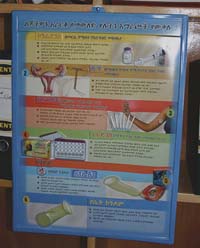
Do you know any people in your community who have special skills at writing poems and songs, or who are good at drawing pictures, or who have other abilities which could be important for creating health education materials? Are there any local materials that could be relevant for health education activities, such as audio-visual equipment or other relevant resources?
Suitable resources may already be available in your community. These resources may include people who are able to draw pictures, write educational poems, and sing local songs that can carry health education messages. In addition, various materials could also be available in your community. For example, traditional musical instruments such as masinqo, krar, washint and kebero may be very useful for your health education sessions. Building up materials is a key part of your job. As you do this, you will be able to add to your resources, so that you do not have to start again every time.
14.3.3 Financial resources
Financial resources are also very important to support your health education activities. However, financial support is often difficult to find specifically for health education activities. To secure money for your activities, you may have to try a variety of different options. The first one is to request community contributions. This is not to suggest that they should necessarily pay money towards the activities. But they may be able to contribute locally available resources in kind. For example, they may be able to prepare coffee while the community members are gathered in the village for health education meetings.
Government and non-governmental organisations may also be able to provide financial support for your activities. So you need to work closely with them. For example, non-governmental organisations working in your area might sponsor some of your activities. They may provide financial support for training heads of households about the proper use of bed nets. Other resources available in the community may include provision of the space to conduct health education sessions. Your community may be able to contribute the kebele administrative office, schools, or other places such as mehber, ider, equib and others. Equipment such as audio equipment, for example a megaphone, may also be available in the community.
Look at the following list and note down the sort of resource contribution each set of people may be able to contribute.
- The community themselves
- Non-governmental organisations (NGOs).
The list below contains just a few suggestions. It does not mean that everyone on the list will definitely provide the resources we have noted!
- Community provides: coffee and hospitality, kebele administration, office space and equipment
- Government or non-governmental organisations provide: sponsorship.
Summary of Study Session 14
In Study Session 14, you have learned that:
- Implementation is the act of converting your planned health-related activities into action, according to your plan of work. Implementation is not a one-off activity, but should be continually reviewed.
- Before the implementation of your plan, there are things that you should consider. These things include organising the community, training the labour force, and identifying and mobilising the available resources.
- Community organising is the process of developing individual and community capacity, and empowering them for collective action. In community organising, it should be possible to develop a network of relationships among people in order to create a favourable environment to work together.
- Community organisation is most often successful if you organise people according to the location, workplace or common characteristics of the participants, or their interest in the issue being addressed.
- Sometimes you may find ready-made or organised community groups. This is a good opportunity for health educators, and you should work with such groups whenever this is possible.
- Once you have organised the community, you should give them training to equip them with the necessary skills and knowledge to be able to include them in health education activities.
- One big resource you have in your community is your people. Therefore, you should mobilise and involve as many local people as possible in all your planned health education activities.
Self-Assessment Questions (SAQs) for Study Session 14
Now that you have completed this study session, you can assess how well you have achieved its Learning Outcomes by answering these questions. Write your answers in your Study Diary and discuss them with your Tutor at the next Study Support Meeting. You can check your answers with the Notes on the Self-Assessment Questions at the end of this Module.
SAQ 14.1 (tests Learning Outcome 14.1)
- a.Write a definition of ‘community organising’ in your own words.
- b.What does the word ‘implementation’ mean?
Answer
- a.Community organising is the process of sensitising and empowering the community in such a way that they can identify and prioritise their needs and objectives, and develop the confidence and the will to achieve them by finding resources through cooperative and collaborative attitudes, practices and community participation. Organising means bringing the community together, and establishing a network of relationships among them so that they work together to achieve common goals.
- b.Implementation is the act of converting planning, goals, objectives and strategies into action, according to your plan of work. For instance, delivering health education for households, counselling mothers, educating youths on sexually transmitted infections, etc. are all part of implementation.
SAQ 14.2 (tests Learning Outcome 14.2)
If you are new to the locality and you want to organise community health education activities, how can you initiate the community organising process?
Answer
Finding community leaders is often a good start. Community leaders are usually good organisers and people tend to follow their example. To facilitate the organising process and make it easier, you may be able to identify community leaders and work with them. If possible, the leader should be someone with good leadership skills, and knowledge of the health problem and the community. In order to identify these community leaders, first approach kebele leaders and ask the name of community leaders. Then, approach those leaders and request their cooperation to work with you.
SAQ 14.3 (tests Learning Outcome 14.2)
Assume that there are already the following existing community groups in the village you are working with: anti-AIDS club, malaria committee, reproductive health committee, women’s association, women’s idirs, student association, and water and sanitation committee. How might you utilise these groups in your health education activities?
Answer
First, you should approach the leaders of each group and understand the aims, interests and the needs of each group. Identify the main areas of their activities, and whether they are interested to work on health-related issues. Then request that the leaders of these groups mobilise their members to participate in health education activities. Plan with them, and involve them in the implementation. These groups are a source of manpower, materials, and space for health education activities.
SAQ 14.4 (tests Learning Outcome 14.3)
Which of the following statements is false about training community groups in health education? In each case, explain why it is incorrect.
A Training is required only for newly organised community groups.
B Training is required only for existing community groups.
C Training is required both for existing and newly organised community groups.
D Training aims to empower the community.
E Training aims to build the community capacity.
F Training aims to improve the skills and knowledge of individuals who are involved in health education activities.
Answer
A is false because it is not only newly organised groups that need training. Depending on the need for training, training should also be given to existing groups.
B is false because newly organised groups also need training
C is true because, based on the existing training gaps, both groups are eligible to receive training to improve their skills and knowledge.
D, E and F are true. The aim of training is to improve the community’s skills, knowledge and capacity. In doing so, the community will be empowered to solve their own health issues, using their own resources.
SAQ 14.5 (tests Learning Outcome 14.4)
To answer part (b) of this question you, may need to read quickly through Study Sessions 12 and 13 again, as these set out the beginning of the planning and implementation process, including needs assessment.
- a.List the types of resources required for health education implementation.
- b.How might you be able to mobilise these resources?
Answer
- a. These are the types of resources required for health education implementation:
- Labour power or personnel to implement health education activities
- Material resources, including educational materials
- Financial resources
- Space.
- b.During needs assessment, all relevant resources for health education activities, including manpower, materials, financial resources, space, and others should be identified. Then approach community leaders, religious leaders, formal leaders like kebele leaders, and other influential people in the community, and discuss with them how to use these resources. To identify manpower, ask them to tell you about individuals who can play a role in health. Then request the cooperation of those people, and involve them in health education activities. Plan with these influential people when, where and how to use the material and other resources, like space, for health.